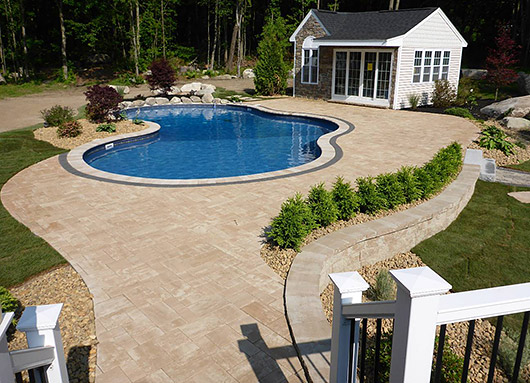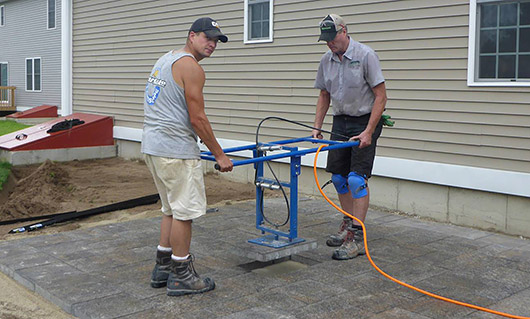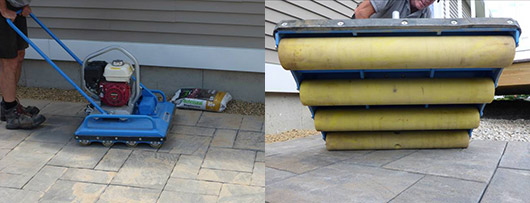Articles written by guest contributors

Insights on installing slabs
By Bill Gardocki, Interstate LandscapeOver the past 3 years we have seen a significant increase in requests from our clients for larger and larger paving slabs. In fact, slabs now account for roughly 75% of my paver work.
My clients like the fact that there are fewer joints to maintain, numerous surface textures to choose from, great color blends and options to install varying random patterns.
Manufacturers are also seeing slab sales grow. One of my dealers, Tim Baney, General Manager of Hudson Quarry in Hudson, NH, says that his slab sales increased 600% from 2014 to 2015. And, half way through the 2016 season, sales of slabs have already surpassed the 2015 total. This trend is being seen throughout the industry.
When does a paver become a slab?
Technically, what is a slab? According to the ICPI Concrete Paver Installer Course book (8th Edition, pg. 90), “Slabs generally have an aspect ratio greater than 4:1, a minimum thickness of 2” and a size larger than 10” x 10”.”The slab craze came up so fast that ASTM standards for manufacturers of paver slabs have just now been set. Under these standards, manufacturers must meet specific psi tolerances, flexural standards, water absorption rates and material deterioration specifications. In contrast, ASTM standards for standard pavers have been around for years.

Bill’s crew install slabs with Pave Mor suction tools because the tools are efficient and prevent the crew from becoming fatigued or injured.
Cautions using slabs
As contractors we must remember that pavers large enough to be classified as slabs perform differently than regular pavers. The aspect ratio is extremely important in selecting the right paver/slab for your job. Aspect ratio measures the unit length to its thickness. When this ratio exceeds 4:1 the units generally cannot be used for vehicular applications.I have seen projects where contractors used 2-3/8” thick slabs that were a combination of 6” x 12”, 12” x 12” and 12” x 18”, and observed how many of the pieces cracked during compaction into the bedding sand (we’ll cover compaction issues below), or cracked from the loads they were required to carry.
When I teach the NCMA Level 1 Certification class I say repeatedly that you don’t want to ask the wall block that you are using to do something it was not designed to do. The same can be said about paving slabs. Don’t install them in applications where the loads are too great for the product.
Increased production rates
When installed correctly, paving slabs offer an opportunity for increased production rates. Our patio production rate is about 275 sf per hour for 3 men. The important thing is that that rate stays the same all day, day after day, because we are not fatiguing ourselves by installing by hand.That’s why we do all of our slab installation with our Pave Mor suction tools. The tools not only speed up production, but also save knees, backs and fingers. We use the 1-man tool for smaller slabs 50 lbs and under, and the 2-man tool for larger slabs.
Most of my patios average about 500 sf. My 2-man prep crew will take about 10 man hours to excavate, infill, compact and level a 500 sf area. Then the 3-man install crew will take about 2.5 man hours to level screed pipes and install our bedding sand. On average, I’d estimate 6 man hours of laying pavers, 2 man hours of cutting depending upon the curves, circle packs, etc., 3 man hours to install edge restraint and sweep in the polysand and 3 man hours of loaming and seeding the disturbed areas.
Adding 2 hours for estimating/planning and 10.5 hours travel time, set up and clean up, I estimate about 40 man hours on a typical 500 sf slab patio install. For the same size patio installing Holland pavers I would figure 46 man hours.

Bill uses a specialty compactor, the Weber VPR 700 Paver Roller, to embed both slabs and pavers into bedding sand. He’s found it prevents cracking, scuffing and chipping.
Compacting a paver/slab surface pushes 12% more sand into joints and increases polymeric sand strength by 20% according to Techniseal’s Phil Graves.
Compacting a paver/slab surface pushes 12% more sand into joints and increases polymeric sand strength by 20% according to Techniseal’s Phil Graves.
Compacting slabs
Using slabs, the embedment compaction process can be tricky. Many manufacturers say not to use a vibratory plate compactor when embedding slabs into the bedding sand. We use the Weber VPR 700 Paver Roller to do all of our embedment of slabs, and of pavers too. There are no worries about cracking, scuffing or chipping the slabs when using this roller compactor.Slab compaction is also extremely important for vibrating polysand into the joints. Phil Graves, Techniseal’s Director of U.S. Sales, told me, “Studies have shown that with compaction on the surface of pavers and slabs you get 12% more sand into the joint. This not only helps with vertical interlock, but also results in a 20% increase in the strength of the polysand.”

Bill Gardocki
Be diligent in your paver slab selection process, install efficiently, use the proper tools, and install all of the components that make our system strong and long lasting. As Phil says, “The customer wants the best finished result possible. Using the best materials, tools and processes is the easiest way to guarantee the best finished product and safeguard against costly call backs. It’s a very easy recipe for successful installation.”
Bill Gardocki is the owner of Interstate Landscape Co. Inc. in Londonderry, NH, installing hardscapes for over 40 years. Bill has taught over 100 classes as an NCMA and ICPI certified instructor. He also provides hardscape seminars for dealer/contractor education days, and in 2013 became the Landscape Construction instructor at his alma mater, the University of New Hampshire. Contact Bill@InterstateLandscapeNH.com













